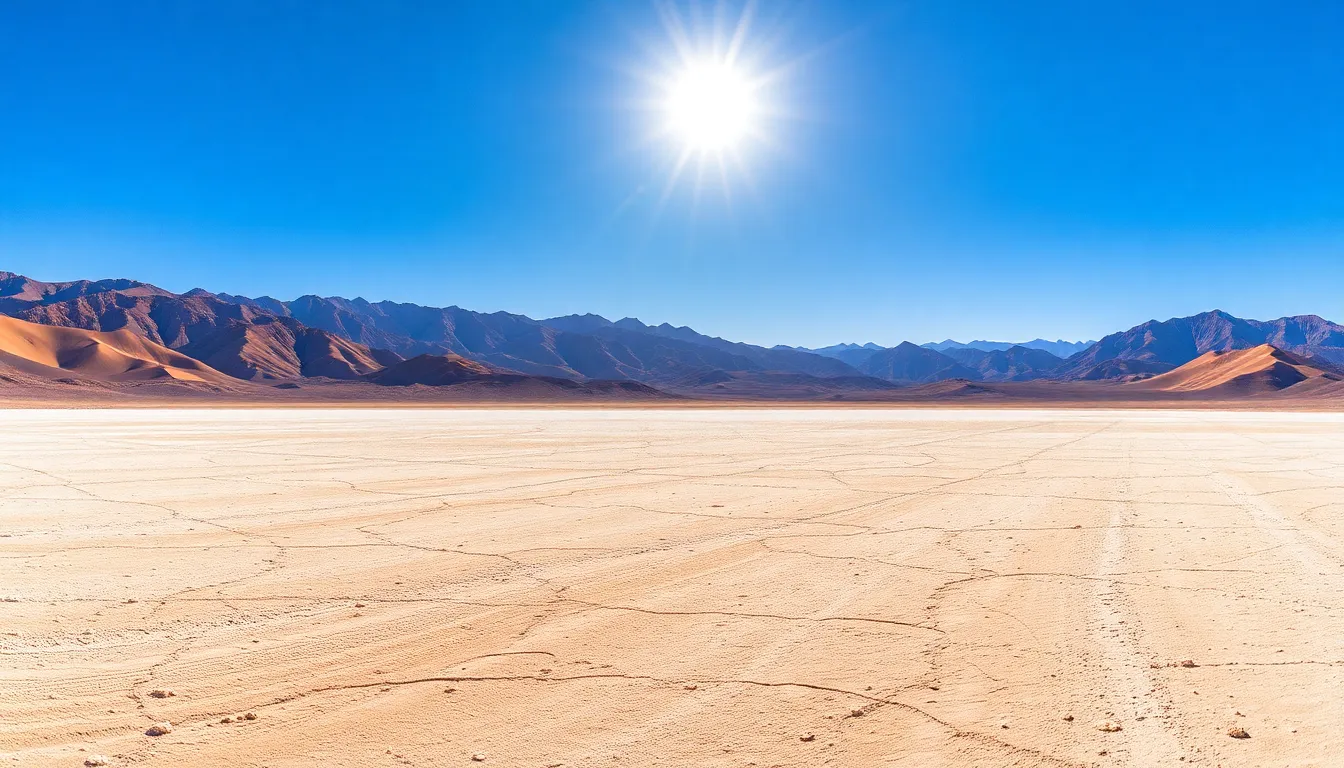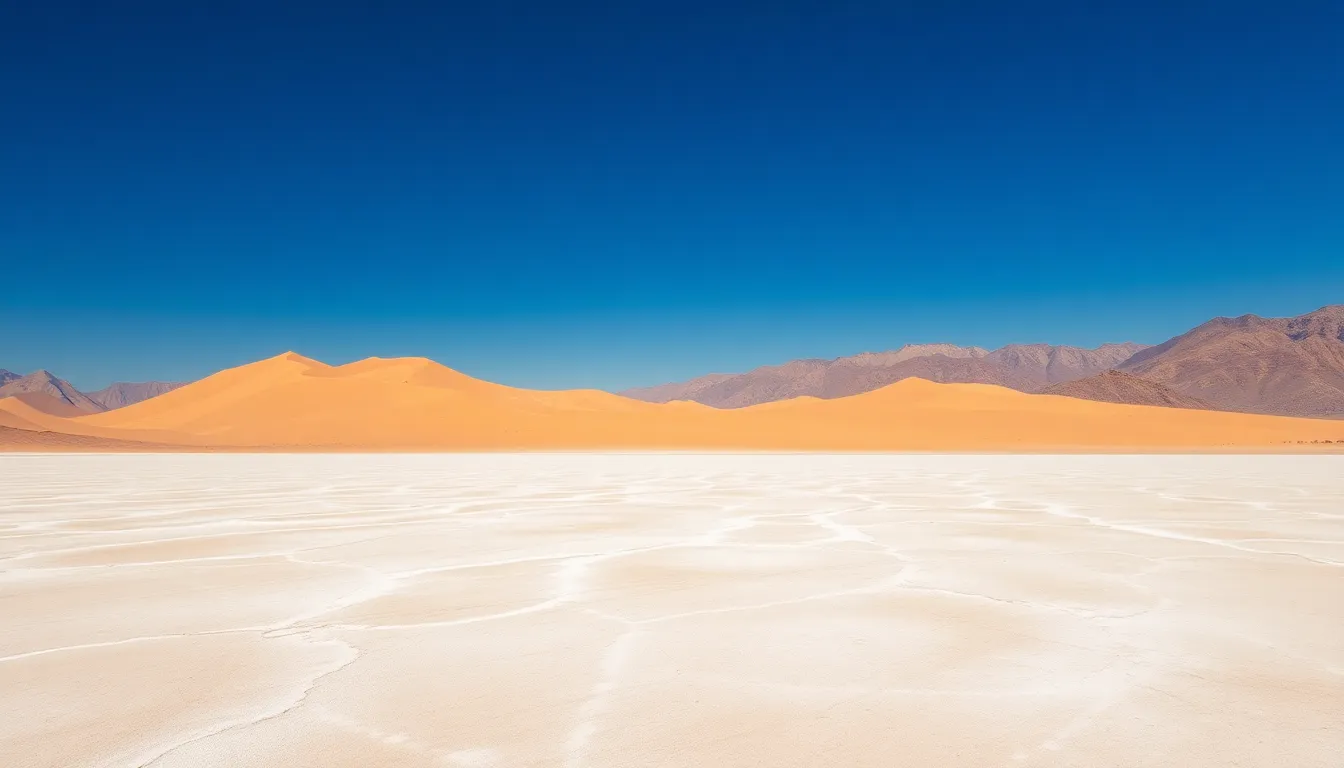Table of Contents
ToggleWhen it comes to heat, one place in the U.S. stands out like a sunburned tourist at the beach. Welcome to the hottest spot in the nation, where temperatures soar higher than a summer romance. If you think your last vacation was sweltering, wait until you hear about this sizzling destination that could make a popsicle melt in seconds.
Overview of the Hottest Place in the US
Death Valley, located in California, holds the title of the hottest place in the United States. Recorded temperatures in this region reach staggering highs, frequently exceeding 120°F (49°C) during the summer months. The highest temperature ever documented was an astonishing 134°F (56.7°C) in July 1913, showcasing the extreme climate conditions.
Located within the Mojave Desert, Death Valley encompasses diverse terrains, including sand dunes, salt flats, and rugged mountains. Its unique geography contributes to the intense heat, with low elevations amplifying temperature levels. Badwater Basin, the lowest point in North America at 282 feet (86 meters) below sea level, often experiences some of the hottest recorded temperatures.
Tourists flock to this unique environment, drawn by its striking landscapes and extreme weather. Visiting offers distinct experiences, such as exploring Furnace Creek and hiking the Golden Canyon. While summer temperatures can be unbearable, visitors often find beauty in the stark contrast of the arid desert.
Weather patterns play a crucial role in this extreme heat. Minimal vegetation and high evaporation rates result in a lack of moisture, further enhancing temperatures. These conditions create an environment where survival is challenging, yet wildlife, such as desert tortoises and various reptiles, adapts to thrive against the odds.
Understanding the climatic extremes of Death Valley provides valuable insights into desert ecosystems. Its record-breaking temperatures and unique features continue to capture the interest of geologists, meteorologists, and adventurers alike.
Climate Factors Contributing to Extreme Heat

Death Valley’s extreme heat results from several climatic elements. Geographic features and seasonal changes play significant roles in shaping this environment.
Geography and Location
Death Valley’s low elevation contributes significantly to its scorching temperatures. Sitting 282 feet below sea level, it experiences a unique atmospheric pressure that intensifies heat retention. The surrounding mountain ranges create a rain shadow effect, leading to minimal precipitation. Additionally, its desert landscape features vast salt flats and dunes that absorb and radiate heat. High sun exposure throughout the year combined with very few clouds leads to consistent temperature extremes. These geographical factors work together to create an almost inhospitable climate.
Seasonal Variations
Seasonal changes dramatically influence Death Valley’s weather patterns. Summer months can see average daily temperatures above 120°F (49°C). In stark contrast, winter temperatures can drop to around 40°F (4°C) at night. This variation creates a harsh daily cycle, where the extreme heat of day sharply contrasts the cooler nights. Spring and fall offer mild weather, but even these seasons can experience sudden spikes in temperature. Convective heat processes in the valley’s basin amplify this variability, showcasing the complex dynamics of its climate.
Record High Temperatures
Death Valley consistently reports some of the highest temperatures in the U.S., setting records that capture global attention. The region experiences notable heat waves, particularly during the summer months.
Notable Heat Waves
In July 2018, Furnace Creek recorded a blistering 127°F (52.8°C), marking one of the hottest days in history for the location. July 2021 brought another extreme when the area logged 130°F (54.4°C) amid a significant heat wave affecting the Southwest. Historical heat waves highlight the area’s relentless temperatures, where multiple days at or exceeding 120°F (49°C) often occur. Such events challenge traditional cooling methods and highlight the environmental aspects of extreme heat.
Comparison with Other Hot Locations
When compared to other hot locations, Death Valley remains unparalleled. Phoenix, Arizona typically sees summer highs around 110°F (43°C) while Las Vegas, Nevada usually hits 105°F (40.6°C). In contrast, Kuwait once recorded a staggering temperature of 129°F (54°C), yet Death Valley’s consistent readings surpass these records. This stark difference emphasizes not only Death Valley’s extreme nature but also its unique desert characteristics that foster intense heat retention and minimal precipitation.
Living Conditions in the Hottest Place
Living in Death Valley presents unique challenges due to extreme heat and arid conditions. Residents and visitors experience daily temperature fluctuations that test human resilience.
Adaptations and Resilience
Creatures have evolved remarkable adaptations to thrive in Death Valley’s harsh environment. Desert tortoises, for example, have developed a capability to store water for extended periods. Various reptiles rely on behavioral adaptations, such as being active during cooler nights. Pockets of vegetation, including creosote bushes and cacti, have deep root systems enabling them to access moisture buried underground. Additionally, many animals employ energy conservation strategies by remaining inactive during the hottest parts of the day. Such adaptations illustrate life’s eagerness to endure despite overwhelming odds.
Infrastructure and Resources
Infrastructure in Death Valley is designed to accommodate the extreme conditions. Communities rely on air conditioning systems for comfort amid summer temperatures. Water supply for residents comes primarily from underground aquifers and municipal sources. Limited power generation is supplemented by solar panels, which harness abundant sunlight. Road maintenance prioritizes resilience to heat-related wear, ensuring access for vehicles and emergency services. Visitors often find amenities with heat-resistant materials, enhancing safety and comfort. All these factors underscore the innovative responses to living in one of the hottest places on Earth.
Tourism and Activities
Death Valley offers a plethora of attractions and activities. Visitors experience breathtaking landscapes and unique geological formations that inspire awe.
Attractions in the Area
Badwater Basin stands as the lowest point in North America. Visitors to Zabriskie Point enjoy stunning sunrises and sunsets over the badlands. Mesquite Flat Sand Dunes provide opportunities for sandboarding and photography. Furnace Creek features the only Visitor Center in the park, equipped with informative exhibits and a gift shop. Stovepipe Wells offers accommodations and restaurants, giving travelers a chance to relax and dine amidst nature’s wonders. Numerous hiking trails cater to all skill levels, including the Golden Canyon and Mosaic Canyon hikes. Unique wildlife sightings, such as desert tortoises and bighorn sheep, capture the interest of nature enthusiasts.
Best Times to Visit
Optimal visiting times fall between October and April. Fall brings pleasant temperatures ideal for daytime exploration. Winter, with average highs around 65°F (18°C), allows for comfortable outdoor activities. Spring showcases blooming wildflowers, which adds vibrant colors to the arid landscape. Summer, while hot, provides a unique challenge for those who thrive in extreme conditions; however, early morning and evening activities remain more enjoyable. Planning activities around sunrise or sunset ensures cooler temperatures and stunning views. Monthly temperatures drastically fluctuate, impacting comfort and safety for visitors.
Death Valley stands as a testament to nature’s extremes. Its record-breaking temperatures and unique landscapes create an environment unlike any other in the United States. Visitors are drawn to its breathtaking scenery and the challenge of experiencing one of the hottest places on Earth.
Understanding the factors that contribute to its intense heat provides a deeper appreciation for this remarkable desert ecosystem. Whether exploring its iconic sites or witnessing its resilient wildlife, Death Valley offers unforgettable experiences that highlight the beauty and harshness of nature. For those willing to brave the heat, the rewards are plentiful and awe-inspiring.







